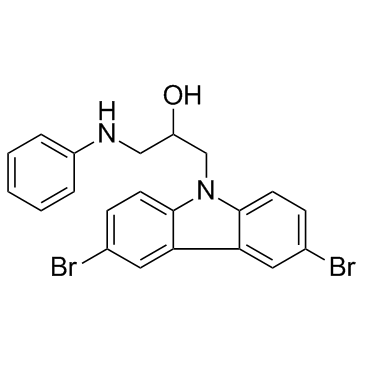P7C3

P7C3 structure
|
Common Name | P7C3 | ||
|---|---|---|---|---|
| CAS Number | 301353-96-8 | Molecular Weight | 474.188 | |
| Density | 1.6±0.1 g/cm3 | Boiling Point | 656.4±55.0 °C at 760 mmHg | |
| Molecular Formula | C21H18Br2N2O | Melting Point | N/A | |
| MSDS | Chinese USA | Flash Point | 350.8±31.5 °C | |
| Symbol |


GHS05, GHS06 |
Signal Word | Danger | |
|
Chronic P7C3 treatment restores hippocampal neurogenesis in the Ts65Dn mouse model of Down Syndrome [Corrected].
Neurosci. Lett. 591 , 86-92, (2015) Down syndrome (DS) is the most common genetic cause of intellectual disability and developmental delay. In addition to cognitive dysfunction, DS patients are marked by diminished neurogenesis, a neuropathological feature also found in the Ts65Dn mouse model o... |
|
|
Contribution of growth differentiation factor 6-dependent cell survival to early-onset retinal dystrophies.
Hum. Mol. Genet. 22(7) , 1432-42, (2013) Retinal dystrophies are predominantly caused by mutations affecting the visual phototransduction system and cilia, with few genes identified that function to maintain photoreceptor survival. We reasoned that growth factors involved with early embryonic retina... |
|
|
Neuroprotective efficacy of aminopropyl carbazoles in a mouse model of amyotrophic lateral sclerosis.
Proc. Natl. Acad. Sci. U. S. A. 109(42) , 17016-21, (2012) We previously reported the discovery of P7C3, an aminopropyl carbazole having proneurogenic and neuroprotective properties in newborn neural precursor cells of the hippocampal dentate gyrus. We have further found that chemicals having efficacy in this in vivo... |
|
|
The P7C3 class of neuroprotective compounds exerts antidepressant efficacy in mice by increasing hippocampal neurogenesis.
Mol. Psychiatry 20(4) , 500-8, (2015) Augmenting hippocampal neurogenesis represents a potential new strategy for treating depression. Here we test this possibility by comparing hippocampal neurogenesis in depression-prone ghrelin receptor (Ghsr)-null mice to that in wild-type littermates and by ... |